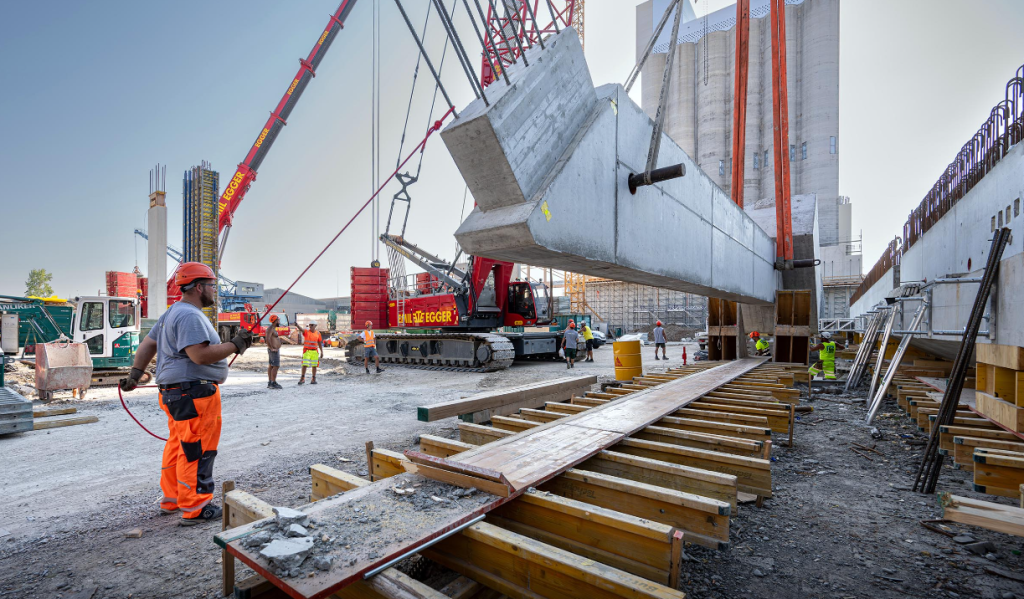
Emil Egger AG has successfully managed a challenging logistics operation, employing four Liebherr cranes to build a new trimodal transshipment terminal at the Rhine port of Basel-Kleinhünigen in Switzerland. Rhenus Port Logistics is investing in this state-of-the-art terminal, which will significantly enhance the port’s capacity and efficiency.
Spanning a total area of 7,300 square meters, the new Terminal 4 includes five hall sections equipped with advanced technology. The terminal will feature five bridge cranes capable of lifting up to 32 tonnes, along with excavators, forklifts, a rail intake hopper for bulk goods, and modern rail and truck scales for efficient goods handling and transportation by road, rail, and water. Key elements of this project are the large prefabricated concrete supports, essential for the crane girders used in loading and unloading ships.

Emil Egger AG was tasked with the logistics of these prefabricated concrete elements. The company deployed two mobile cranes—an LTM 1350-6.1 and an LTM 1650-8.1—along with two crawler cranes—an LR 1250 and an LR 11000—to expertly navigate the complexities of the construction site. With access restricted on all sides by neighboring buildings, the Südquaistrasse road, and the Rhine, establishing a functional logistics operation within such a confined space was no small feat. The installation areas were similarly challenging, situated within the emerging building itself, with concrete work proceeding in parallel.
During the construction process, the LR 1250 played a crucial role in stripping the formwork from the 64-tonne diagonal supports fabricated on-site and moving them within the construction site. The crane then loaded these supports onto low-loaders for transport.

In the autumn, the LR 11000, Switzerland’s largest crawler crane, took over to install the crane track supports and external bone girders. This crane moved two supports weighing 211 tonnes each over a 59-meter radius and four additional supports weighing 265 tonnes each over 45 meters. Configured with a 72-meter-long boom and V-frame, the crane’s sophisticated processes allowed for efficient ballast management without the need for an auxiliary crane. According to Michael Egger from Emil Egger, “We first used the V-frame five years ago and our entire team can no longer imagine operating this powerful crane without it.”
The VarioTray also proved indispensable. With a small pallet and 180 tonnes of suspended ballast, supports were lifted and shifted over the water with over 400 tonnes of suspended ballast. Project manager Andreas Schönenberger noted, “The VarioTray was a highlight of the construction phase.”

The 1,000-tonne crawler crane also extended the wall panels up to the final height of the hall and installed 14 bone girders connecting the panels. Each lift involved a 140-tonne load at a radius of 44 meters, requiring meticulously planned assembly and dismantling due to limited space.

The LTM 1350-6.1 mobile crane was instrumental in lifting the diagonal supports, stripped of their formwork by the LR 1250, and tilting them to the correct angle for placement. These supports will later cantilever freely over the water to support the crane girders.
Towards the end of the construction, the LTM 1650-8.1 mobile crane closed the gaps in the cast-in-place concrete wall panels and installed the last six bone girders. This 650-tonne machine lifted the 90-tonne, 32-meter-long beams at a radius of around 14 meters, driving within the construction site after installing each pair of beams.
Emil Egger AG’s adept handling of this complex project highlights the crucial role of precise logistics and advanced crane technology in modern port construction.
